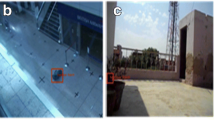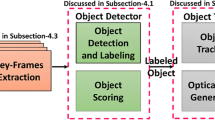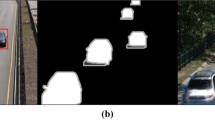Abstract
Abandoned and stolen object detection is a challenging task due to occlusion, changes in lighting, large perspective distortion, and the similarity in appearance of different people. This paper presents real-time detection methods of abandoned and stolen objects in a complex video. The adaptive background modeling method is applied to stable tracking and the ghost image removing. To detect abandoned and stolen objects, the methods determine spatio-temporal relationship between moving people and suspicious drops. The space first detection method measures the distance between a moving object and a non-moving object in spatial change analysis. The time first detection method conducts temporal change analysis and then spatial change analysis. The potential abandoned object is classified as a definite abandoned or stolen object by two-level detection approach. The time-to-live timer is applied by adjusting several key parameters on each camera and environment. In experiments, we show the experimental results to evaluate our proposed methods using benchmark datasets.
















Similar content being viewed by others
References
Bird N, Atev S, Caramelli N, Martin R, Masoud O, Papanikolopoulos N (2006) Real time, online detection of abandoned objects in public areas. In: Robotics and Automation, 2006. ICRA 2006. Proceedings 2006 IEEE International Conference on, pp 3775–3780. IEEE
Beyan C, Yigit A, Temizel A (2011) Fusion of thermal-and visible-band video for abandoned object detection. J Electron Imag 20(3):033,001–033,001
Cheng S, Luo X, Bhandarkar S (2007) A multiscale parametric background model for stationary foreground object detection. In: Motion and Video Computing, 2007. WMVC’07. IEEE Workshop on, pp 18–18. IEEE
Cho SH, Nam Y, Hong S, Cho W (2010) Locally initiating line-based object association in large scale multiple cameras environment. TIIS 4(3):358–379
Collins R, Lipton A, Kanade T A System for Video Surveillance and Monitoring. In: American Nuclear Society 8th Internal Topical Meeting on Robotics and Remote Systems (1999). http://citeseerx.ist.psu.edu/viewdoc/summary?doi=10.1.1.42.6273
Corporation I Sourceforge.net: Open computer vision library. http://sourceforge.net/projects/opencvlibrary/
Evangelio RH, Sikora T (2011) Static object detection based on a dual background model and a finite-state machine. EURASIP J Image Video Process 2011:1–11
Fan Q, Pankanti S (2011) Modeling of temporarily static objects for robust abandoned object detection in urban surveillance. In: Advanced Video and Signal-Based Surveillance (AVSS). In: 2011 8th IEEE International Conference on, pp 36–41. doi:10.1109/AVSS.2011.6027290
Fan Q, Pankanti S Robust foreground and abandonment analysis for large-scale abandoned object detection in complex surveillance videos. In: Advanced Video and Signal-Based Surveillance (AVSS), 2012 IEEE Ninth International Conference on, pp 58–63. doi:10.1109/AVSS.2012.62
Ferrando S, Gera G, Regazzoni C (2006) Classification of unattended and stolen objects in video-surveillance system. In: Video and Signal Based Surveillance, 2006. AVSS ’06. IEEE International Conference on, p 21. doi:10.1109/AVSS.2006.32
Ground truth of i-lids bag and vehicle detection challenge (avss 2007) task 1: Abandoned baggage. ftp://motinas.elec.qmul.ac.uk/pub/iLids/iLids_avss2007_ground_truth.zip
Hassanpour R, Atalay V (2004) Camera auto-calibration using a sequence of 2d images with small rotations. Pattern Recogn Lett 25(9):989–997. doi:10.1016/j.patrec.2004.02.011
Heikkila J, Silven O (1997) A four-step camera calibration procedure with implicit image correction. In: Proceedings of the 1997 Conference on Computer Vision and Pattern Recognition (CVPR ’97), CVPR ’97, pp 1106. http://dl.acm.org/citation.cfm?id=794189.794489. IEEE Computer Society, DC, USA
i lids: i-lids dataset for avss (2007). ftp://motinas.elec.qmul.ac.uk/pub/iLids/
Jing-Ying C, Huei-Hung L, Liang-Gee C (2010) Localized detection of abandoned luggage. EURASIP Journal on Advances in Signal Processing 2010
Lucchese L (2005) Geometric calibration of digital cameras through multi-view rectification. Image Vis Comput 23(5):517–539. doi:10.1016/j.imavis.2005.01.001, http://www.sciencedirect.com/science/article/pii/S0262885605000090
Lu S, Zhang J, Feng D (2007) An efficient method for detecting ghost and left objects in surveillance video. doi:10.1109/AVSS.2007.4425368, pp 540–545
Maddalena L, Petrosino A (2013) Stopped object detection by learning foreground model in videos. IEEE Trans Neural Netw Learn Syst 24(5):723–735
Mathew R, Yu Z, Zhang J (2005) Detecting new stable objects in surveillance video. In: Multimedia Signal Processing, 2005 IEEE 7th Workshop on, pp 1–4. IEEE
Nam Y, Rho S, Park J (2012) Inference topology of distributed camera networks with multiple cameras. Multimedia Tools and Applications pp 1–21. doi:10.1007/s11042-012-0997-0, (to appear in print).
Pets 2006: Performance evaluation of tracking and surveillance 2006 benchmark data (2006). http://www.cvg.rdg.ac.uk/PETS2006/
Pets 2007: Performance evaluation of tracking and surveillance 2007 benchmark data (2007). http://www.cvg.rdg.ac.uk/PETS2007/
Porikli F (2007) Detection of temporarily static regions by processing video at different frame rates. In: Advanced Video and Signal Based Surveillance, 2007. AVSS 2007. IEEE Conference on, pp 236–241. IEEE
Porikli F, Ivanov Y, Haga T (2008) Robust abandoned object detection using dual foregrounds. EURASIP J Adv Signal Process 2008:30
Sanmiguel JC, MartíNez JM (2012) A semantic-based probabilistic approach for real-time video event recognition. Comput Vis Image Underst 116(9):937–952. doi:10.1016/j.cviu.2012.04.005
Tian Y, Senior A, Lu M (2012) Robust and efficient foreground analysis in complex surveillance videos. Mach Vis Appl 23(5):967–983
Thiel G (2000) Automatic cctv surveillance-towards the virtual guard. Aerospace and Electronic Systems Magazine. IEEE 15(7):3–9. doi:10.1109/62.854018
Tian YL, Feris R, Hampapur A (2008) Real-Time Detection of Abandoned and Removed Objects in Complex Environments. In: The Eighth International Workshop on Visual Surveillance - VS2008. http://hal.inria.fr/inria-00325775. Graeme Jones and Tieniu Tan and Steve Maybank and Dimitrios Makris, Marseille, France
Tripathi RK, Jalal AS, Bhatnagar C (2013) A framework for abandoned object detection from video surveillance. In: Computer Vision, Pattern Recognition, Image Processing and Graphics (NCVPRIPG), 2013 Fourth National Conference on, pp 1–4. IEEE
Wang J, Shi F, Zhang J, Liu Y (2008) A new calibration model of camera lens distortion. Pattern Recog 41(2):607–615. doi:10.1016/j.patcog.2007.06.012, http://www.sciencedirect.com/science/article/pii/S0031320307003020
Zhang Z (2000) A flexible new technique for camera calibration. Pattern Analysis and Machine Intelligence. IEEE Trans 22(11):1330–1334. doi:10.1109/34.888718
Author information
Authors and Affiliations
Corresponding author
Additional information
This research was supported by the Soonchunhyang University Research Fund (No. 20140226) and also was supported by the MSIP(Ministry of Science, ICT&Future Planning), Korea, under the C-ITRC(Convergence Information Technology Research Center) support program (NIPA-2014-H0401-14-1022) supervised by the NIPA(National IT Industry Promotion Agency).
Rights and permissions
About this article
Cite this article
Nam, Y. Real-time abandoned and stolen object detection based on spatio-temporal features in crowded scenes. Multimed Tools Appl 75, 7003–7028 (2016). https://doi.org/10.1007/s11042-015-2625-2
Received:
Revised:
Accepted:
Published:
Issue Date:
DOI: https://doi.org/10.1007/s11042-015-2625-2




